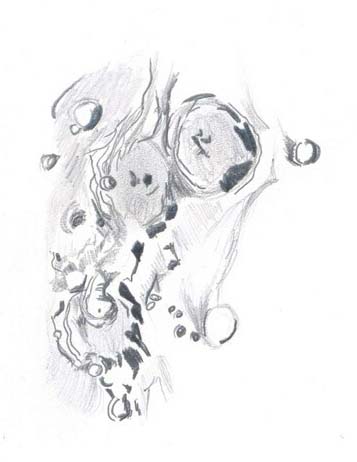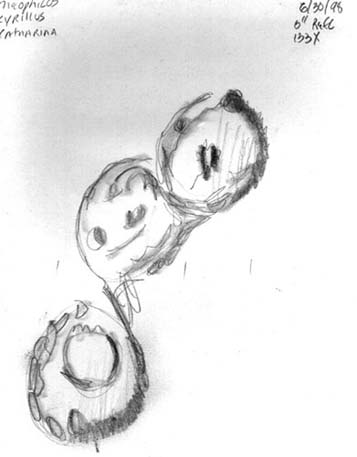
12/02/08 Pencil. 20:15UT - 21:15UT - 0 degrees C 5.73 days. Illumination 35.9%. Seeing Antoniadi 1 Transparency Poor. 8-inch reflector. 8mm TVP eyepiece 2xBarlow. FL 1200mm. Mag 300x Image rotated 180 degrees and also a small adjustment rotation to match Jane's sketch.
It would have been nice to catch this trio directly on the terminator, but the Sun's continued rise chased the terminator several hundred miles further on.
Nevertheless on this cold evening I was attracted by the remaining deep shadows nestling under the east rims of Theophilus, Cyrillus and Catharina. I was blessed with unusual steady seeing, Antoniadi 1, which allowed me the luxury of popping in a 2x Barlow to bring the magnification up to 300x. The apparent sunken section within Catharina is, it seems, an overlapping crater Catharina P, very clearly visible that evening. I enjoyed the flowing rims of this lunar triplet.
Beaumont and Madler to the east were just about defined by the angle of the Sun's light, a subtle ridged line linked them visually together. More of Dee's awesome lunar sketches (Jane says so) are here.

On 30/06/1998 - a 7 day waxing moon. Seeing and transparency were average in urban Anaheim Hills, California on sketch night. I used a 6-inch Pierre Schwaar Super Companion f/5.2 reflector (I bought about half a dozen of these wonderful telescopes from Pierre before he died). No matter which family member I visit, every one in my family has one of these fine telescopes. I used a 6mm Vixen Lanthanum eyepiece in my sister's Wendy's 6-inch F/5.2 at 133x.
From top to bottom, first, Theophilis, a 100km ring mountain. Theophilis has terraced walls, a flat floor and central peaks found in the Tycho class of complex-crater morphology. The crater walls reach 1200m above the surrounding terrain, while the central peak reaches a height of 1400 m. Next is Cyrillis, with disintegrated walls. 98 km in diameter. Note the cracks on the crater floor. The third crater in this glorious set is Catharina, named for St. Catharina of Alexandria. It's also a damaged crater 100 km in diameter. NOte the large crater, Catharina P within Catherina.
All three are lovely on the terminator every 7th day of the lunar cycle, a good public star gazing night. More lunar sketches are here.